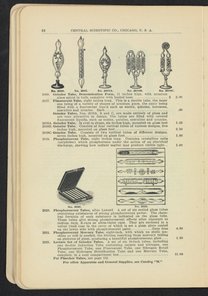Geissler Tube
- After 1857

 This work is licensed under a Creative Commons Attribution 4.0 International License.
This work is licensed under a Creative Commons Attribution 4.0 International License.The Geissler Tube is a sealed glass cylinder of a unique design with a metal electrode at each end. The Geissler Tube was invented by the German glassblower and physicist, Johann Heinrich Wilhelm Geissler (1814-1879) in 1857. Geissler tubes were the first gas discharge tubes. Each contains rarefied gasses such as neon or argon; conductive fluids; or ionizable minerals or metals. When voltage is applied to the apparatus, electric current flows through the tube causing its contents to fluoresce. A multitude of colors and effects can be achieved by modifying the gaseous contents of the tube. Geissler tubes were mass-produced beginning in the 1880s as novelty and entertainment devices. By the early 20th century, the technology was commercialized and evolved into neon lighting.
| Property | Value |
|---|---|
| Format | |
| Genre | |
| Medium | |
| Extent |
|
| Subject | |
| Rights | Creative Commons Attribution 4.0 International License |
| Credit line |
|
Institutional location
| Department |
|---|
Related Items
Cite as
Science History Institute. Geissler Tube. Photograph, 2021. Science History Institute. Philadelphia. https://digital.sciencehistory.org/works/pty356d.
This citation is automatically generated and may contain errors.






